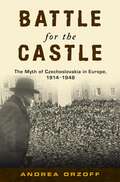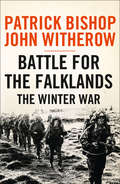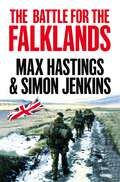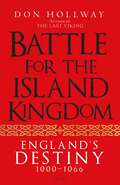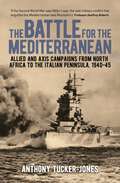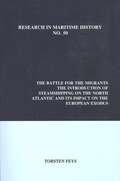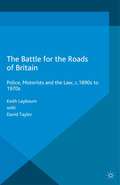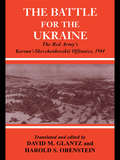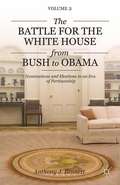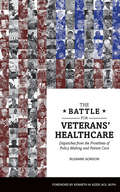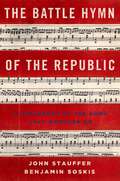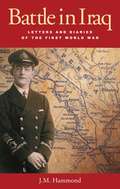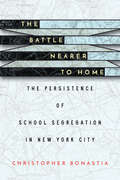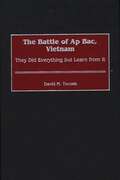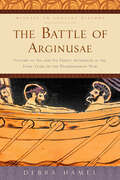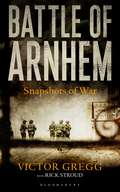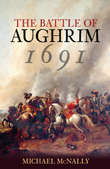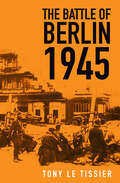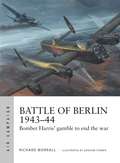- Table View
- List View
Battle for the Castle: The Myth of Czechoslovakia in Europe, 1914-1948
by Andrea OrzoffAfter World War I, diplomats and leaders at the Paris Peace Talks redrew the map of Europe, carving up ancient empires and transforming Europe's eastern half into new nation-states. Drawing heavily on the past, the leaders of these young countries crafted national mythologies and deployed them at home and abroad. Domestically, myths were a tool for legitimating the new state with fractious electorates. In Great Power capitals, they were used to curry favor and to compete with the mythologies and propaganda of other insecure postwar states. The new postwar state of Czechoslovakia forged a reputation as Europe's democratic outpost in the East, an island of enlightened tolerance amid an increasingly fascist Central and Eastern Europe. In Battle for the Castle, Andrea Orzoff traces the myth of Czechoslovakia as an ideal democracy. The architects of the myth were two academics who had fled Austria-Hungary in the Great War's early years. Tomáas Garrigue Masaryk, who became Czechoslovakia's first president, and Edvard Benes, its longtime foreign minister and later president, propagated the idea of the Czechs as a tolerant, prosperous, and cosmopolitan people, devoted to European ideals, and Czechoslovakia as a Western ally capable of containing both German aggression and Bolshevik radicalism. Deeply distrustful of Czech political parties and Parliamentary leaders, Benes and Masaryk created an informal political organization known as the Hrad or "Castle." This powerful coalition of intellectuals, journalists, businessmen, religious leaders, and Great War veterans struggled with Parliamentary leaders to set the country's political agenda and advance the myth. Abroad, the Castle wielded the national myth to claim the attention and defense of the West against its increasingly hungry neighbors. When Hitler occupied the country, the mythic Czechoslovakia gained power as its leaders went into wartime exile. Once Czechoslovakia regained its independence after 1945, the Castle myth reappeared. After the Communist coup of 1948, many Castle politicians went into exile in America, where they wrote the Castle myth of an idealized Czechoslovakia into academic and political discourse. Battle for the Castle demonstrates how this founding myth became enshrined in Czechoslovak and European history. It powerfully articulates the centrality of propaganda and the mass media to interwar European cultural diplomacy and politics, and the tense, combative atmosphere of European international relations from the beginning of the First World War well past the end of the Second.
Battle for the Castle: The Myth of Czechoslovakia in Europe, 1914-1948
by Andrea OrzoffAfter World War I, diplomats and leaders at the Paris Peace Talks redrew the map of Europe, carving up ancient empires and transforming Europe's eastern half into new nation-states. Drawing heavily on the past, the leaders of these young countries crafted national mythologies and deployed them at home and abroad. Domestically, myths were a tool for legitimating the new state with fractious electorates. In Great Power capitals, they were used to curry favor and to compete with the mythologies and propaganda of other insecure postwar states. The new postwar state of Czechoslovakia forged a reputation as Europe's democratic outpost in the East, an island of enlightened tolerance amid an increasingly fascist Central and Eastern Europe. In Battle for the Castle, Andrea Orzoff traces the myth of Czechoslovakia as an ideal democracy. The architects of the myth were two academics who had fled Austria-Hungary in the Great War's early years. Tomáas Garrigue Masaryk, who became Czechoslovakia's first president, and Edvard Benes, its longtime foreign minister and later president, propagated the idea of the Czechs as a tolerant, prosperous, and cosmopolitan people, devoted to European ideals, and Czechoslovakia as a Western ally capable of containing both German aggression and Bolshevik radicalism. Deeply distrustful of Czech political parties and Parliamentary leaders, Benes and Masaryk created an informal political organization known as the Hrad or "Castle." This powerful coalition of intellectuals, journalists, businessmen, religious leaders, and Great War veterans struggled with Parliamentary leaders to set the country's political agenda and advance the myth. Abroad, the Castle wielded the national myth to claim the attention and defense of the West against its increasingly hungry neighbors. When Hitler occupied the country, the mythic Czechoslovakia gained power as its leaders went into wartime exile. Once Czechoslovakia regained its independence after 1945, the Castle myth reappeared. After the Communist coup of 1948, many Castle politicians went into exile in America, where they wrote the Castle myth of an idealized Czechoslovakia into academic and political discourse. Battle for the Castle demonstrates how this founding myth became enshrined in Czechoslovak and European history. It powerfully articulates the centrality of propaganda and the mass media to interwar European cultural diplomacy and politics, and the tense, combative atmosphere of European international relations from the beginning of the First World War well past the end of the Second.
Battle for the Falklands: The Winter War
by Patrick Bishop John Witherow‘Boldly planned, bravely executed and brilliantly accomplished’ was Margaret Thatcher’s assessment of the Falklands campaign. But what did the war mean to the men in the trenches and below decks?
The Battle for the Falklands
by Max Hastings Simon JenkinsThe Falklands War was one of the strangest in British history – 28,000 men sent to fight for a tiny relic of empire 8,000 miles from home. At the time, many Britons saw it as a tragic absurdity, but the British victory confirmed the quality of British arms and boosted the political fortunes of the Conservative government. But it left a chequered aftermath; it was of no wider significance for British interests and taught no lessons. It has since been overshadowed by the two Gulf Wars, however, its political ramifications cannot be overestimated. Max Hastings’ and Simon Jenkins’ account of the conflict is a modern classic of war reportage and the definitive book on the war. Republished as part of the Pan Military Classics series, The Battle for the Falklands is a vivid chronicle of a call to arms and a thoughtful and informed analysis of an astonishing chapter in the history of our times.
Battle for the Island Kingdom: England's Destiny 1000–1066
by Don HollwayA rich history of the years leading up to 1066 when Vikings, Anglo-Saxons and Normans vied for the English crown. A tale of loyalty, treason and military might. In a saga reminiscent of Game of Thrones and The Last Kingdom, Battle for the Island Kingdom reveals the life-and-death struggle for power which changed the course of history. The six decades leading up to 1066 were defined by bloody wars and intrigues, in which three peoples vied for supremacy over the island kingdom. In this epic retelling, Don Hollway (The Last Viking) recounts the clashes of Vikings, Anglo-Saxons and Normans, their warlords and their conniving queens. It begins with the Viking Cnut the Great, forging three nations into his North Sea Empire while his Saxon wife Aelfgifu rules in his stead and schemes for England's throne. Her archenemy is Emma of Normandy, widow of Saxon king Aethelred, claiming Cnut's realm in exchange for her hand in marriage. Their sons become rivals, pawns in their mothers' wars until they can secure their own destinies. And always in the shadows is Godwin of Wessex, playing all sides to become the power behind the throne until his son Harold emerges as king of all of England. But Harold's brother Tostig turns traitor, abandons the Anglo-Saxons and joins the army of the last great Viking, Harald Hardrada, where together they meet their fate at the battle of Stamford Bridge. And all this time watching from across the water is William, the Bastard, fighting to secure his own Norman dukedom, but with an eye on the English crown.
Battle for the Island Kingdom: England's Destiny 1000–1066
by Don HollwayA rich history of the years leading up to 1066 when Vikings, Anglo-Saxons and Normans vied for the English crown. A tale of loyalty, treason and military might. In a saga reminiscent of Game of Thrones and The Last Kingdom, Battle for the Island Kingdom reveals the life-and-death struggle for power which changed the course of history. The six decades leading up to 1066 were defined by bloody wars and intrigues, in which three peoples vied for supremacy over the island kingdom. In this epic retelling, Don Hollway (The Last Viking) recounts the clashes of Vikings, Anglo-Saxons and Normans, their warlords and their conniving queens. It begins with the Viking Cnut the Great, forging three nations into his North Sea Empire while his Saxon wife Aelfgifu rules in his stead and schemes for England's throne. Her archenemy is Emma of Normandy, widow of Saxon king Aethelred, claiming Cnut's realm in exchange for her hand in marriage. Their sons become rivals, pawns in their mothers' wars until they can secure their own destinies. And always in the shadows is Godwin of Wessex, playing all sides to become the power behind the throne until his son Harold emerges as king of all of England. But Harold's brother Tostig turns traitor, abandons the Anglo-Saxons and joins the army of the last great Viking, Harald Hardrada, where together they meet their fate at the battle of Stamford Bridge. And all this time watching from across the water is William, the Bastard, fighting to secure his own Norman dukedom, but with an eye on the English crown.
The Battle for the Mediterranean: Allied and Axis Campaigns from North Africa to the Italian Peninsula, 1940-45
by Anthony Tucker-Jones"This book provides a strategic overview of the war that is interweaved with fascinating personal accounts, its campaigns and battles." - Professor Geoffrey Roberts.If the Second World War was Hitler's war, the vast military conflict that engulfed the Mediterranean between 1940 and 1945 was Mussolini's. In this exciting and illuminating account, Anthony Tucker-Jones explores the major campaigns across the whole Mediterranean, from the struggle for control of the Suez Canal to the Allied landings in the French Riviera in the summer of 1944. Includes: • Battle for Crete •The Desert Air War• Second Battle of El Alamein• Operation Crusader • Invasion of Sicily (Operation Husky)The actions of famous generals are introduced, including Erwin Rommel, Bernard Montgomery and George S. Patton, and how their strategic offensives pushed back Axis forces. Augmented by fascinating photographs and forwarded by Professor Geoffrey Roberts, The Battle for the Mediterranean tells the story of an all-encompassing conflict, by land, air and sea.
The Battle for the Migrants: Introduction of Steamshipping on the North Atlantic and Its Impact on the European Exodus (Research in Maritime History #50)
by Torsten FeysThis book approaches the well-documented study of European mass migration to the United States of America from the viewpoint of mass migration as a business venture. The overall purpose is to demonstrate that maritime and migration histories are interlinked and dependent on a deeper understanding of the social, economic, and political factors at work in the nineteenth century Atlantic community. It centres on both the evolution of the port of Rotterdam as a migration gateway, and the crucial role of the Holland-America line as a regulator of the North American passenger trade. The first part of the book explores the simultaneous rise of transatlantic mass migration and long-distance steamshipping between 1830 to 1870. The second part, divided into five chapters, explores how mass migration became a big business between 1870 and 1914, and scrutinises how steamship companies organised and provided initiatives for transoceanic migration, plus the role of shipping agents and agent-networks, and how passenger services were constructed within transatlantic networks. Over the course of the text it becomes increasingly clear that by approaching mass migration as a trade issue, the role of steamship companies in the facilitation of transatlantic migration is rendered both intrinsic and pivotal. It consists of an introduction containing contextual information, two sections providing historical overviews, five chapters exploring different aspects of the shipping industry’s response to mass migration, conclusion, bibliography, and six appendices of passenger, destination, agent, and advertising statistics.
The Battle for the Roads of Britain: Police, Motorists and the Law, c.1890s to 1970s
by David Taylor Keith LaybournPolicing in Britain was changed fundamentally by the rapid emergence of the automobile at the beginning of the twentieth century. This book seeks to examine how the police reacted to this challenge and moved to segregate the motorist from the pedestrian in an attempt to eliminate the 'road holocaust' that ensued.
Battle for the Ukraine: The Korsun'-Shevchenkovskii Operation (Soviet (Russian) Study of War)
by David M. Glantz Harold S. OrensteinA comprehensive guide to the battle for the Ukraine from the Soviet perspective during the winter of 1943-1944. This volume is an unexpurgated translation of the originally classified Soviet General Staff Study No.14.
Battle for the Ukraine: The Korsun'-Shevchenkovskii Operation (Soviet (Russian) Study of War)
by David M. Glantz Harold S. OrensteinA comprehensive guide to the battle for the Ukraine from the Soviet perspective during the winter of 1943-1944. This volume is an unexpurgated translation of the originally classified Soviet General Staff Study No.14.
The Battle for the White House from Bush to Obama: Volume II Nominations and Elections in an Era of Partisanship
by A. BennettAnthony Bennett guides us through the events of the four elections of the 21st century, showing how this era of partisanship has reshaped not only presidential nominations and elections, but the American presidency and politics itself.
The Battle for Veterans’ Healthcare: Dispatches from the Front Lines of Policy Making and Patient Care
by Suzanne GordonIn The Battle for Veterans' Healthcare, award-winning author Suzanne Gordon takes us to the front lines of federal policymaking and healthcare delivery, as it affects eight million Americans whose military service makes them eligible for Veterans Health Administration (VHA) coverage.Gordon’s collected dispatches provide insight and information too often missing from mainstream media reporting on the VHA and from Capitol Hill debates about its future. Drawing on interviews with veterans and their families, VHA staff and administrators, health care policy experts and Congressional decision makers, Gordon describes a federal agency under siege that nevertheless accomplishes its difficult mission of serving men and women injured, in myriad ways, while on active duty.The Battle for Veterans’ Healthcare is an essential primer on VHA care and a call to action by veterans, their advocacy organizations, and political allies. Without lobbying efforts and broader public understanding of what’s at stake, a system now functioning far better than most private hospital systems may end up looking more like them, to the detriment of patients and providers alike.
The Battle Hymn of the Republic: A Biography of the Song That Marches On
by John Stauffer Benjamin SoskisIt was sung at Ronald Reagan's funeral, and adopted with new lyrics by labor radicals. John Updike quoted it in the title of one of his novels, and George W. Bush had it performed at the memorial service in the National Cathedral for victims of September 11, 2001. Perhaps no other song has held such a profoundly significant--and contradictory--place in America's history and cultural memory than the "The Battle Hymn of the Republic." In this sweeping study, John Stauffer and Benjamin Soskis show how this Civil War tune has become an anthem for cause after radically different cause. The song originated in antebellum revivalism, with the melody of the camp-meeting favorite, "Say Brothers, Will You Meet Us." Union soldiers in the Civil War then turned it into "John Brown's Body." Julia Ward Howe, uncomfortable with Brown's violence and militancy, wrote the words we know today. Using intense apocalyptic and millenarian imagery, she captured the popular enthusiasm of the time, the sense of a climactic battle between good and evil; yet she made no reference to a particular time or place, allowing it to be exported or adapted to new conflicts, including Reconstruction, sectional reconciliation, imperialism, progressive reform, labor radicalism, civil rights movements, and social conservatism. And yet the memory of the song's original role in bloody and divisive Civil War scuttled an attempt to make it the national anthem. The Daughters of the Confederacy held a contest for new lyrics, but admitted that none of the entries measured up to the power of the original. "The Battle Hymn" has long helped to express what we mean when we talk about sacrifice, about the importance of fighting--in battles both real and allegorical--for the values America represents. It conjures up and confirms some of our most profound conceptions of national identity and purpose. And yet, as Stauffer and Soskis note, the popularity of the song has not relieved it of the tensions present at its birth--tensions between unity and discord, and between the glories and the perils of righteous enthusiasm. If anything, those tensions became more profound. By following this thread through the tapestry of American history, The Battle Hymn of the Republic illuminates the fractures and contradictions that underlie the story of our nation.
The Battle Hymn of the Republic: A Biography of the Song That Marches On
by John Stauffer Benjamin SoskisIt was sung at Ronald Reagan's funeral, and adopted with new lyrics by labor radicals. John Updike quoted it in the title of one of his novels, and George W. Bush had it performed at the memorial service in the National Cathedral for victims of September 11, 2001. Perhaps no other song has held such a profoundly significant--and contradictory--place in America's history and cultural memory than the "The Battle Hymn of the Republic." In this sweeping study, John Stauffer and Benjamin Soskis show how this Civil War tune has become an anthem for cause after radically different cause. The song originated in antebellum revivalism, with the melody of the camp-meeting favorite, "Say Brothers, Will You Meet Us." Union soldiers in the Civil War then turned it into "John Brown's Body." Julia Ward Howe, uncomfortable with Brown's violence and militancy, wrote the words we know today. Using intense apocalyptic and millenarian imagery, she captured the popular enthusiasm of the time, the sense of a climactic battle between good and evil; yet she made no reference to a particular time or place, allowing it to be exported or adapted to new conflicts, including Reconstruction, sectional reconciliation, imperialism, progressive reform, labor radicalism, civil rights movements, and social conservatism. And yet the memory of the song's original role in bloody and divisive Civil War scuttled an attempt to make it the national anthem. The Daughters of the Confederacy held a contest for new lyrics, but admitted that none of the entries measured up to the power of the original. "The Battle Hymn" has long helped to express what we mean when we talk about sacrifice, about the importance of fighting--in battles both real and allegorical--for the values America represents. It conjures up and confirms some of our most profound conceptions of national identity and purpose. And yet, as Stauffer and Soskis note, the popularity of the song has not relieved it of the tensions present at its birth--tensions between unity and discord, and between the glories and the perils of righteous enthusiasm. If anything, those tensions became more profound. By following this thread through the tapestry of American history, The Battle Hymn of the Republic illuminates the fractures and contradictions that underlie the story of our nation.
Battle in Iraq: Letters and Diaries of the First World War
by J. M. HammondThis moving and unusual story of a British engineer who becomes caught up in the horrifying events of the First World War vividly illuminates life - and death - on the Mesopotamian Front. At the outbreak of War, William Reed had recently arrived in the region to work as a marine engineer. By the time fighting ceased in 1918, not only his own life but the whole course of the history of the Middle East had been transformed. Reed began his career in Persia just before the outbreak of war as chief engineer of the Julnar, a ship owned by the Euphrates and Tigris Steam Navigation Company in Baghdad, and was subsequently drawn into the war effort as a Royal Naval Reservist. In this gripping history of Iraq during the First World War, Josephine Hammond skilfully weaves together her grandfather's diaries, placing his personal adventures against the backdrop of the unfolding drama of war. Reed's own involvement in the war effort, carrying troops and supplies up and down the Tigris River, ended abruptly when he was captured by the Turks in 1916. He spent two years in a Turkish prison camp and the frustrations and privations of this period of captivity are also vividly evoked here. Battle in Iraq offers an invaluable record of events in Iraq during the First World War as well as sensitively drawing out the unavoidable parallels with the contemporary conflict and the long-term consequences of international interference in the region.
The Battle Nearer to Home: The Persistence of School Segregation in New York City
by Christopher BonastiaDespite its image as an epicenter of progressive social policy, New York City continues to have one of the nation's most segregated school systems. Tracing the quest for integration in education from the mid-1950s to the present, The Battle Nearer to Home follows the tireless efforts by educational activists to dismantle the deep racial and socioeconomic inequalities that segregation reinforces. The fight for integration has shifted significantly over time, not least in terms of the way "integration" is conceived, from transfers of students and redrawing school attendance zones, to more recent demands of community control of segregated schools. In all cases, the Board eventually pulled the plug in the face of resistance from more powerful stakeholders, and, starting in the 1970s, integration receded as a possible solution to educational inequality. In excavating the history of New York City school integration politics, in the halls of power and on the ground, Christopher Bonastia unearths the enduring white resistance to integration and the severe costs paid by Black and Latino students. This last decade has seen activists renew the fight for integration, but the war is still far from won.
The Battle Nearer to Home: The Persistence of School Segregation in New York City
by Christopher BonastiaDespite its image as an epicenter of progressive social policy, New York City continues to have one of the nation's most segregated school systems. Tracing the quest for integration in education from the mid-1950s to the present, The Battle Nearer to Home follows the tireless efforts by educational activists to dismantle the deep racial and socioeconomic inequalities that segregation reinforces. The fight for integration has shifted significantly over time, not least in terms of the way "integration" is conceived, from transfers of students and redrawing school attendance zones, to more recent demands of community control of segregated schools. In all cases, the Board eventually pulled the plug in the face of resistance from more powerful stakeholders, and, starting in the 1970s, integration receded as a possible solution to educational inequality. In excavating the history of New York City school integration politics, in the halls of power and on the ground, Christopher Bonastia unearths the enduring white resistance to integration and the severe costs paid by Black and Latino students. This last decade has seen activists renew the fight for integration, but the war is still far from won.
The Battle of Ap Bac, Vietnam: They Did Everything but Learn from It (Contributions in Military Studies)
by David M. ToczekToczek provides the first description of the entire battle of Ap Bac and places it in the larger context of the Vietnam War. The study thoroughly examines the January 1963 battle, complete with detailed supporting maps. Ironically, Ap Bac's great importance lies in American policymakers' perception of the battle as unimportant; for all their intelligence and drive, senior American government officials missed the early warning signs of a flawed policy in Southeast Asia by ignoring the lessons of the defeat of the South Vietnamese Army (ARVN) on 2 January 1963.The outcome of Ap Bac was a direct reflection of how the U.S. Army organized, equipped, and trained the ARVN. With all the ARVN officer corps's shortcomings, the South Vietnamese Army could not successfully conduct an American combined arms operations against a smaller, less well-equipped enemy. American leadership, both military and civilian, failed to draw any connection between ARVN's dismal performance and American policies toward South Vietnam. Although certain tactical changes resulted from the battle, the larger issue of American policy remained unchanged, including the structure of the advisory system.
The Battle of Arginusae: Victory at Sea and Its Tragic Aftermath in the Final Years of the Peloponnesian War (Witness to Ancient History)
by Debra HamelA pivotal skirmish involving nearly three hundred Athenian and Spartan ships toward the end of the Peloponnesian War, the Battle of Arginusae was at the time the largest naval battle ever fought between warring Greeks. It was a crucial win for the Athenians, since losing the battle would have led to their total defeat by Sparta and, perhaps, the slaughter and enslavement of their entire population. Paradoxically, the win at Arginusae resulted in one of the worst disasters to befall the Athenians during the brutal twenty-seven-year war.Due to a combination of factors�incompetent leadership, the weariness of the sailors, a sudden storm�the commanders on the scene failed to rescue the crews of twenty-five Athenian ships that had been disabled during the battle. Thousands of men, many of them injured, were left clinging to the wreckage of their ships awaiting help that never came. When the Athenians back home heard what had happened, they deposed the eight generals who had been in command during the battle. Two of these leaders went into exile; the six who returned to Athens were tried and eventually executed.The Battle of Arginusae describes the violent battle and its horrible aftermath. Debra Hamel introduces readers to Athens and Sparta, the two thriving superpowers of the fifth century B.C. She provides a summary of the events that caused the long war and discusses the tactical intricacies of Greek naval warfare. Recreating the claustrophobic, unhygienic conditions in which the ships' crews operated, Hamel unfolds the process that turned this naval victory into one of the most infamous chapters in the city-state's history. Aimed at classics students and general readers, the book also provides an in-depth examination of the fraught relationship between Athens' military commanders and its vaunted sovereign democracy.
Battle of Arnhem: Snapshots Of War (Snapshots Of War Ser.)
by Victor Gregg Rick Stroud'I invite the reader to travel the road alongside these men, many of whom are destined to be buried in some foreign field, others to survive and endeavour to forget, and others to live a life of mental torture as they try to adjust after the storms of battle have receded into the history books.'–Victor Gregg, veteran of the Rifle Brigade and 10th Parachute Regiment.This is the story of how Victor Gregg switched from being a rifleman to a birdman.After sweeping through France and Belgium in the summer of 1944, the Allies were poised to enter the Netherlands to secure key bridges and towns along the Allied axis of advance. Gregg and his fellow riflemen are asked to volunteer for the Parachute Regiment, the staunch 'once a rifleman always a rifleman' overruled by a promise of extra leave. The British airborne forces landed some distance from their objectives and were quickly hampered by unexpected resistance. Only a small force was able to reach the Arnhem road bridge, and reinforcements were unable to advance north as quickly as anticipated, therefore failing to relieve the airborne troops according to schedule. After nine days of fighting, the shattered remains of the British 1st Airborne Division were withdrawn. The troops had been up against unimaginable odds, with countless tragic losses along the way. Gregg is subsequently captured and sent to a prisoner of war camp in Dresden, where the infamous and tragic bombings were about to begin.
The Battle of Aughrim 1691: A New History Of Ireland's Bloodiest Battle (Century Of The Soldier Ser. #27)
by Michael McNallyWith over 60,000 combatants, the Battle of the Boyne, which took place on 1 July 1690 was the largest battle ever fought on Irish soil, and has long been regarded as the pivotal event of the Williamite War. But despite the Boyne's celebrated place in Irish protestant folklore, the critical engagement of the campaign was to take place the following year outside the village of Aughrim, in County Galway. Here the outnumbered and outgunned Jacobites, their backs to the wall, faced the Williamite army in a battle that was to decide the course of Irish, and indeed European history. In the first major history of the battle in forty years, Michael McNally brings vividly to life the personalities and events of the bloodiest day in Irish history. Placing the battle firmly in the context of the wider campaign, and of early modern European power politics, he uses evocative eyewitness testimony to reconstruct the events of that fateful encounter, and reveal just how close to defeat the Williamites came.
The Battle of Berlin
by Tony Le TissierThe Battle of Berlin was a conflict of unprecedented scale. The Soviets massed 1,600,000 troops for Operation Berlin, and but Marshal Zhukov's his initial attack floundered and was so costly that he had to revise his plans for taking of the city when Stalin allowed his rival, Marshal Koniev, to intervene. The fight for Berlin thus became a contest for the prize of the Reichstag, fought in the sea of rubble left by Allied aerial bombardments, now reduced further by the mass of Soviet siege artillery. Meanwhile, Hitler and his courtiers sought to continue the struggle in the totally unrealistic atmosphere that prevailed in his bunker, while soldiers and civilians alike suffered and perished unheeded all around them.
Battle of Berlin 1943–44: Bomber Harris' gamble to end the war (Air Campaign)
by Richard WorrallThroughout late-1943 into early-1944, an epic struggle raged over the skies of Germany between RAF Bomber Command and the Luftwaffe. This campaign had been undertaken by the Commander-in-Chief Bomber Command, Air Chief Marshal Sir Arthur Harris, and was baptized 'The Battle of Berlin'. The Berlin campaign was a hard, desperate slog. Struggling against dreadful and bitter winter weather, Bomber Command 'went' to Berlin a total of sixteen times, suffering increasingly severe losses throughout the winter of 1943/44 in the face of a revitalized German air-defence. The campaign remains controversial and the jury, even today, is ultimately undecided as to what it realistically achieved. Illustrated throughout with full-colour artwork depicting the enormous scale of the campaign, this is the story of the RAF's much debated attempt to win the war through bombing alone.
Battle of Berlin 1943–44: Bomber Harris' gamble to end the war (Air Campaign #11)
by Richard WorrallThroughout late-1943 into early-1944, an epic struggle raged over the skies of Germany between RAF Bomber Command and the Luftwaffe. This campaign had been undertaken by the Commander-in-Chief Bomber Command, Air Chief Marshal Sir Arthur Harris, and was baptized 'The Battle of Berlin'. The Berlin campaign was a hard, desperate slog. Struggling against dreadful and bitter winter weather, Bomber Command 'went' to Berlin a total of sixteen times, suffering increasingly severe losses throughout the winter of 1943/44 in the face of a revitalized German air-defence. The campaign remains controversial and the jury, even today, is ultimately undecided as to what it realistically achieved. Illustrated throughout with full-colour artwork depicting the enormous scale of the campaign, this is the story of the RAF's much debated attempt to win the war through bombing alone.
